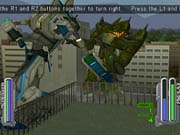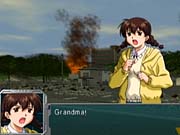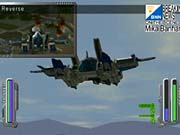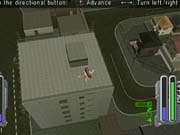Robot Alchemic Drive Preview
We take a detailed look at Enix's upcoming giant-robot simulator.
Robot Alchemic Drive is easily one of the most interesting giant robot games currently in the pipeline, and we should be grateful that it's coming to North America. It presents a very unique and intricate take on the lumbering dealers of devastation that have become part of our popular culture, and the results seem to be a whole lot of fun. The game is currently in development by a former Human team (the now-defunct studio originally responsible for the Fire Pro games), and its heritage is immediately apparent. The very same team was responsible for the PlayStation's acclaimed Remote Control Dandy (which never saw a North American release, sadly), and RAD has inherited that game's fresh RC-inspired control mechanics. It allows for some heavy-hitting action, and it makes even moving around feel both satisfying and exciting. The developer has also managed to make the robots look very neat and given them some cool abilities.

RAD's defining feature is that it doesn't cast you as a mech pilot so much as a mech controller. That is, you're not sitting in the mech itself, but rather controlling it from outside its body. You actually control both the character and the robot during the game's missions, and the relationship between the two comes into play in a big way. When controlling the robot, you're only able to see what falls into the human's natural field of vision. Conversely, if you smash things up too crazily as the robot, some of the fallout could adversely affect the human's health--tons of falling concrete and wood will do that. The battles, as a result, feel especially hectic, as you're constantly switching between human and the robot in order to compensate for dynamic changes in the dimensions of the battlefield. The pacing is intense and definitely unique, and it's coupled with a control scheme that makes the most of it.

When you're controlling your human character, you get a set of standard, stripped-down third-person controls. Direction and movement are both mapped to the left analog stick, and the X button makes you jump. Hold the button down, and you'll levitate, gradually gaining altitude and falling when a meter next to your health bar is drained. Hitting select drops you into a sort of first-person view, with the point of origin being your character, and gives you direct control of your robot. And that's when the script gets flipped. The PS2 controller acts as a sort of radio transmitter, allowing you to control each of your robot's limbs independently. The L1 and R1 buttons move left and right legs, respectively, and the length of the strides is regulated by how hard you press the buttons. If you press them both together, you'll crouch, and if you time the release properly, you'll jump in the air. Do this when your opponent is prone, and you'll be able to pounce on it in a nasty way. The analog sticks, further, control your right and left arms. Depending on the directions you input, you'll flail your arms in different ways, with special attacks triggered by combinations of back-and-forth and circular motions. Various projectile attacks are mapped to the triangle and circle buttons, including missiles, lasers, and the like. Finally, if your robot is fortunate enough to have an alternate form, hitting the square button will allow you to swap between the two. It definitely feels like a challenging control scheme, but it's also quite satisfying--everything feels harsh and heavy, and it makes the carnage going on all about you hit home quite nicely.
A Tale of Three Giants

The one-battle demo that we were given by Enix actually took the form of a mini scenario, replete with dialogue, scripted scenes, and the whole nine yards. Three robots and three characters were at our disposal, with the humans being fairly indistinct outside of their appearance and the robots anything but. Though the humans were all nameless, they did have very distinct designs. They included a young, idealistic type with a leather jacket and crazy hair, a tall, dashing sort with a cool demeanor, and a kind-natured young woman in a funky spring dress. All of them control identically, and they're all oddly referred to as "chairman" by the characters in the game, which is probably a localization bug, a product of an incomplete scenario, or a little both. The characters were designed by Toshihiro Kawamoto, of Cowboy Bebop fame, which will likely mean a great deal to many people.
The robots you'll have access to are all quite different, however. First up is Vavel, which looks like a blockier version of Tranzor-Z. It shoots missiles out of its chest and packs a mean wallop with its fists, but it has no alternate form. In terms of relative power, the game describes it as "median," which sort of makes it the default robot. Next up is Gllang, which is big, bulky, and easily the strongest of the three. Its alternate form is a powerful tank packed with all kinds of mech-stopping artillery. It's a bit cumbersome and slow, though, even as far as giant robots are concerned, so its powerful arsenal and raw strength have to make up for that fact. Last is Laguiole, the weakest but nimblest of the lot. Its alternate form looks like a Veritech fighter. Laguiole isn't as strong as the other two, but it's much quicker on its feet, making it the easiest to maneuver throughout the dense cityscapes.

The scenario in our demo started us out in the middle of a big city, and our immediate goal was to reach a subway platform. Once there, we met up with a young girl named Nanao, seconds before a news bulletin announced that a giant robot was attacking the city. After investigating, we were urged by the young girl to head to her grandma's house, which, as it happens, was in the very area the robot was headed for. Tragically, the giant robot reaches the area at the same time as the player and shoots missiles at grandma's house. That's when a friendly but disheveled scientist, arrives to brief us on the nature of the threat and hand us the transmitter to our very own giant robot. Minutes later, he's apparently killed by a blast from the robot. This drives our character to action. We then meet Dr. Wiltz, an apparently Austrian scientist, at our robot's hangar before taking control of it and going after the attacker. The actual battle is more instructional than anything else, as we had to wait for said scientist's prompts before enacting any moves on our own. An onscreen display in the form of a live news broadcast provided us with an alternate view of the battle, which was quite useful in situations when our own view was less than optimal.
This short scenario definitely left us wanting more. The robots look great, and the gameplay systems seem to be firing on all channels. Robot Alchemic Drive has been an absolutely pleasant surprise so far, and it's definitely one of the highest games on our most-wanted lists at this point. Look for more here soon.
Got a news tip or want to contact us directly? Email news@gamespot.com
Join the conversation